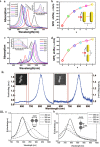Plasmonic nanotechnology for photothermal applications - an evaluation
- PMID: 37025366
- PMCID: PMC10071519
- DOI: 10.3762/bjnano.14.33
Plasmonic nanotechnology for photothermal applications - an evaluation
Abstract
The application of plasmonic nanoparticles is motivated by the phenomenon of surface plasmon resonance. Owing to the tunability of optothermal properties and enhanced stability, these nanostructures show a wide range of applications in optical sensors, steam generation, water desalination, thermal energy storage, and biomedical applications such as photothermal (PT) therapy. The PT effect, that is, the conversion of absorbed light to heat by these particles, has led to thriving research regarding the utilization of plasmonic nanoparticles for a myriad of applications. The design of conventional nanomaterials for PT conversion has focussed predominantly on the manipulation of photon absorption through bandgap engineering, doping, incorporation, and modification of suitable matrix materials. Plasmonic nanomaterials offer an alternative and attractive approach in this regard, through the flexibility in the excitation of surface plasmons. Specific advantages are the considerable improved bandwidth of the absorption, a higher efficiency of photon absorption, facile tuning, as well as flexibility in the synthesis of plasmonic nanomaterials. This review of plasmonic PT (PPT) research begins with a theoretical discussion on the plasmonic properties of nanoparticles by means of the quasi-static approximation, Mie theory, Gans theory, generic simulations on common plasmonic material morphologies, and the evaluation processes of PT performance. Further, a variety of nanomaterials and material classes that have potential for PPT conversion are elucidated, such as plasmonic metals, bimetals, and metal-metal oxide nanocomposites. A detailed investigation of the essential, but often ignored, concept of thermal, chemical, and aggregation stability of nanoparticles is another part of this review. The challenges that remain, as well as prospective directions and chemistries, regarding nanomaterials for PT conversion are pondered on in the final section of the article, taking into account the specific requirements from different applications.
Keywords: nanoparticle heating; phonons; photothermal; plasmonic; stability; surface plasmon resonance.
Copyright © 2023, Indhu et al.
Figures




























Similar articles
-
Noble metals on the nanoscale: optical and photothermal properties and some applications in imaging, sensing, biology, and medicine.Acc Chem Res. 2008 Dec;41(12):1578-86. doi: 10.1021/ar7002804. Acc Chem Res. 2008. PMID: 18447366
-
Optothermal properties of plasmonic inorganic nanoparticles for photoacoustic applications.Photoacoustics. 2021 Jun 14;23:100281. doi: 10.1016/j.pacs.2021.100281. eCollection 2021 Sep. Photoacoustics. 2021. PMID: 34194975 Free PMC article. Review.
-
Let There Be Heat: Silica-Coated Gold Nanoparticles as Photothermal Reactors for Chemical Synthesis.Acc Chem Res. 2025 May 6;58(9):1424-1434. doi: 10.1021/acs.accounts.5c00072. Epub 2025 Apr 22. Acc Chem Res. 2025. PMID: 40262050 Free PMC article.
-
Directional Damping of Plasmons at Metal-Semiconductor Interfaces.Acc Chem Res. 2022 Jul 5;55(13):1845-1856. doi: 10.1021/acs.accounts.2c00001. Epub 2022 Jun 13. Acc Chem Res. 2022. PMID: 35696292
-
Second Near-Infrared Plasmonic Nanomaterials for Photoacoustic Imaging and Photothermal Therapy.Small. 2023 Jul;19(30):e2300539. doi: 10.1002/smll.202300539. Epub 2023 Apr 14. Small. 2023. PMID: 37060228 Review.
Cited by
-
Photothermal therapy using graphene quantum dots.APL Bioeng. 2023 Aug 21;7(3):031502. doi: 10.1063/5.0160324. eCollection 2023 Sep. APL Bioeng. 2023. PMID: 37614868 Free PMC article. Review.
-
Nanotechnology-Based Strategies for Safe and Effective Immunotherapy.Molecules. 2024 Dec 11;29(24):5855. doi: 10.3390/molecules29245855. Molecules. 2024. PMID: 39769944 Free PMC article. Review.
-
Eco-friendly synthesis of ZnO, CuO, and ZnO/CuO nanoparticles using extract of spent Pleurotus ostreatus substrate, and their antioxidant and anticancer activities.Discov Nano. 2025 Feb 13;20(1):35. doi: 10.1186/s11671-025-04199-6. Discov Nano. 2025. PMID: 39945970 Free PMC article.
-
Advancements in tantalum based nanoparticles for integrated imaging and photothermal therapy in cancer management.RSC Adv. 2024 Oct 23;14(46):33681-33740. doi: 10.1039/d4ra05732e. eCollection 2024 Oct 23. RSC Adv. 2024. PMID: 39450067 Free PMC article. Review.
-
Numerical Simulation of Light to Heat Conversion by Plasmonic Nanoheaters.Nano Lett. 2025 Jan 8;25(1):230-235. doi: 10.1021/acs.nanolett.4c04872. Epub 2024 Dec 19. Nano Lett. 2025. PMID: 39701587 Free PMC article.
References
-
- Dirker J, Juggurnath D, Kaya A, Osowade E A, Simpson M, Lecompte S, Noori Rahim Abadi S M A, Voulgaropoulos V, Adelaja A O, Dauhoo M Z, et al. Front Energy Res. 2019;6:10.3389/fenrg.2018.00147. doi: 10.3389/fenrg.2018.00147. - DOI
-
- Gärtner W W. Phys Rev. 1961;122(2):419–424. doi: 10.1103/physrev.122.419. - DOI
-
- Cortezon-Tamarit F, Ge H, Mirabello V, Theobald M B M, Calatayud D G, Pascu S I. Inorganic and Organometallic Transition Metal Complexes with Biological Molecules and Living Cells. Academic Press; 2017. Carbon Nanotubes and Related Nanohybrids Incorporating Inorganic Transition Metal Compounds and Radioactive Species as Synthetic Scaffolds for Nanomedicine Design; pp. 245–327. - DOI
-
- Li S, Wang X, Hu R, Chen H, Li M, Wang J, Wang Y, Liu L, Lv F, Liang X-J, et al. Chem Mater. 2016;28(23):8669–8675. doi: 10.1021/acs.chemmater.6b03738. - DOI
Publication types
LinkOut - more resources
Full Text Sources
